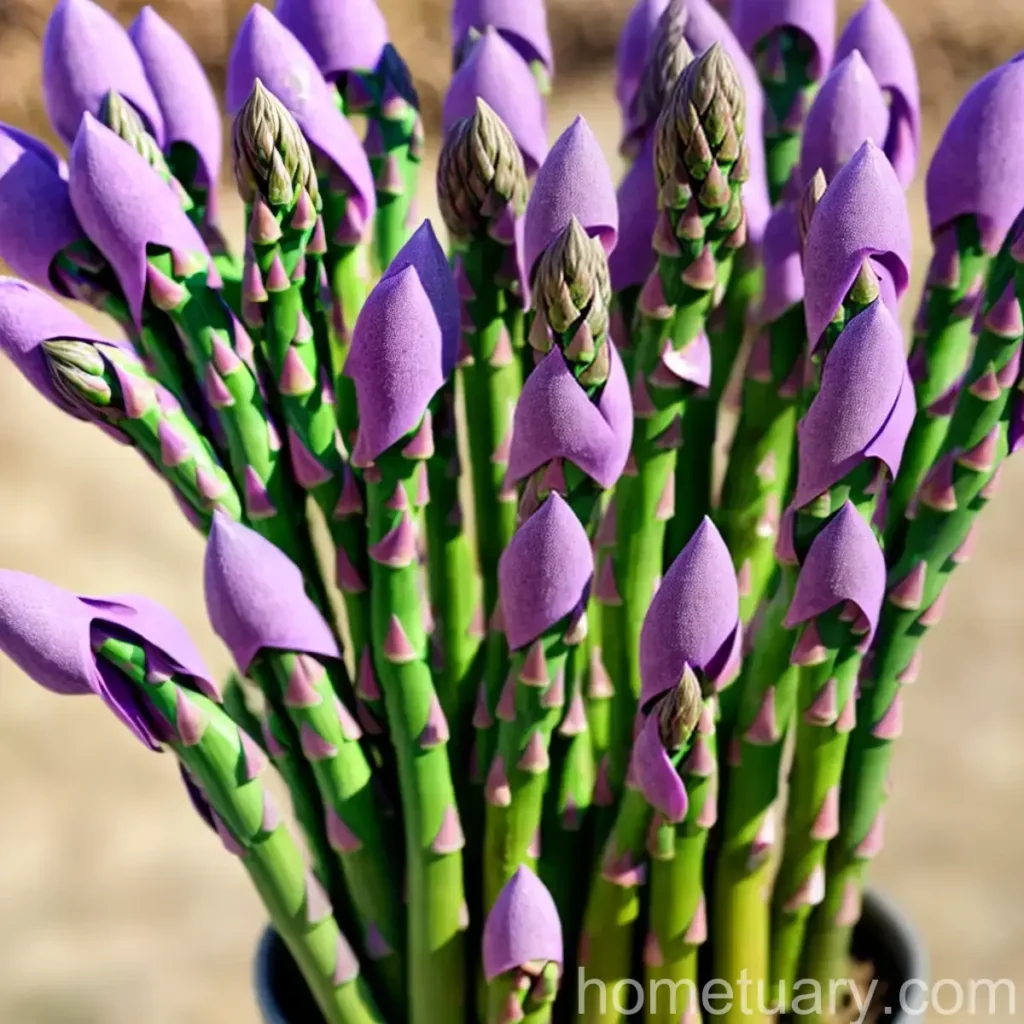The Allure of Purple Passion Asparagus (Asparagus officinalis ‘Purple Passion’)
Introduction
Asparagus, a perennial flowering plant of the Asparagaceae family, is a popular vegetable celebrated for its tender shoots and unique flavor. Its cultivation dates back to ancient times, and today it continues to be a cherished addition to culinary creations worldwide.
In this comprehensive guide, we will explore the fascinating world of Purple Passion asparagus (Asparagus officinalis ‘Purple Passion’). This cultivar, known for its striking purple color and exceptional taste, captivates the hearts and palates of gardening enthusiasts and gourmands alike. From its cultural requirements to its practical uses and potential challenges, we will delve into every aspect of this esteemed plant variety.
What is Purple Passion Asparagus (Asparagus officinalis ‘Purple Passion’)?
Purple Passion asparagus (Asparagus officinalis ‘Purple Passion’) is a cultivar of asparagus renowned for its vibrant purple spears. This delightful variation of asparagus offers not only ornamental appeal but also delectable flavors, making it a prized addition to gardens and dining tables.
Key Takeaways
Culture
- Scientific Name: Asparagus officinalis ‘Purple Passion’
- Type: Perennial
- Hardiness Zone: 3-8
- Mature Height: 4-5 feet
- Harvest Time: Spring to early summer
Uses
- Culinary: The tender shoots of Purple Passion asparagus are valued for their exquisite taste and can be used in a variety of culinary creations.
- Ornamental: The striking appearance of the purple spears makes Purple Passion asparagus an attractive addition to garden landscapes.
Growing Conditions
Water
Purple Passion asparagus requires consistent moisture throughout the growing season, especially during the establishment phase. Adequate watering is essential to support the development of healthy and robust spears.
Sunlight
For optimal growth and productivity, Purple Passion asparagus necessitates full sun exposure. A minimum of 6-8 hours of direct sunlight per day is recommended to ensure vigorous growth and bountiful harvests.
Fertilizer
When it comes to fertilization, asparagus thrives in nutrient-rich soils. Incorporating organic matter such as compost or well-aged manure into the soil prior to planting provides essential nutrients for the plants. Additionally, a balanced fertilizer application in the early spring can further support the growth and development of Purple Passion asparagus.
Soil
Well-draining, fertile soils are ideal for cultivating Purple Passion asparagus. A slightly acidic to neutral soil pH ranging from 6.0 to 7.0 creates an optimal environment for robust growth and prolific spear production.
Pruning
Regular pruning, particularly during the growing season, is essential to maintain the health and vigor of Purple Passion asparagus plants. Removing any yellowing or brown foliage and dead stems helps prevent the spread of diseases and encourages the continuous development of new spears.
Propagation and Container Gardening
Propagation
Purple Passion asparagus can be propagated through seeds or divisions. For seed propagation, sowing the seeds in well-prepared soil in the early spring can yield young plants for future transplanting. Division of established crowns in the early spring is another effective method for propagating Purple Passion asparagus.
Container Gardening
While Purple Passion asparagus is traditionally cultivated in garden beds, it can also thrive in large containers with proper care and attention. Selecting containers with a depth of at least 12 inches and a diameter suitable for accommodating multiple plants enables successful container gardening for this vibrant asparagus cultivar.
Popularity
Purple Passion asparagus has garnered widespread popularity among gardening enthusiasts and culinary aficionados for its delightful combination of aesthetic allure and delectable taste. Its distinctively colored spears and versatile culinary applications have contributed to its rise as a sought-after addition to home gardens and professional kitchens.
Common Diseases and Pests
Disease Diagnosis
Purple Passion asparagus is susceptible to various diseases, including asparagus rust, fusarium crown and root rot, and asparagus mildew. Vigilant monitoring for symptoms such as discolored or spotted foliage, stunted growth, and abnormal spear development is crucial for early disease diagnosis and prompt intervention.
Common Pests
Asparagus beetles and aphids are common pests that can pose a threat to Purple Passion asparagus. Regular inspection of plants and the implementation of suitable pest control measures, such as the application of organic insecticidal soaps, are essential for mitigating pest pressures.
Botanist’s Tips
- Mulching: Applying a layer of mulch around Purple Passion asparagus plants aids in moisture retention, weed suppression, and temperature regulation, fostering a conducive growth environment.
- Companion Planting: Pairing Purple Passion asparagus with beneficial companions such as tomatoes, basil, and parsley can offer natural pest control and promote overall garden health.
- Winter Care: Providing adequate winter protection, such as mulching and cutting back the foliage after the first frost, helps safeguard Purple Passion asparagus plants from cold temperatures and frost damage.
Fun Facts
- The purple coloration of Purple Passion asparagus is attributed to its high anthocyanin content, adding an aesthetically pleasing visual element to culinary presentations.
- Asparagus has been celebrated for centuries for its purported aphrodisiac properties and esteemed as a delicacy fit for royalty.
Links to External Resources
For further information on the cultivation, care, and culinary uses of Purple Passion asparagus, consider exploring the following external resources:
– The National Center for Home Food Preservation: Asparagus
– University of California Agriculture and Natural Resources: Asparagus Production in California
– Royal Horticultural Society: Asparagus
In conclusion, Purple Passion asparagus (Asparagus officinalis ‘Purple Passion’) holds a special place in the realm of horticulture and gastronomy, captivating enthusiasts with its alluring visual appeal and delightful flavors. By embracing the guidelines and insights presented in this comprehensive guide, individuals can embark on a rewarding journey of cultivating, savoring, and celebrating the remarkable virtues of Purple Passion asparagus in their gardens and kitchens.















